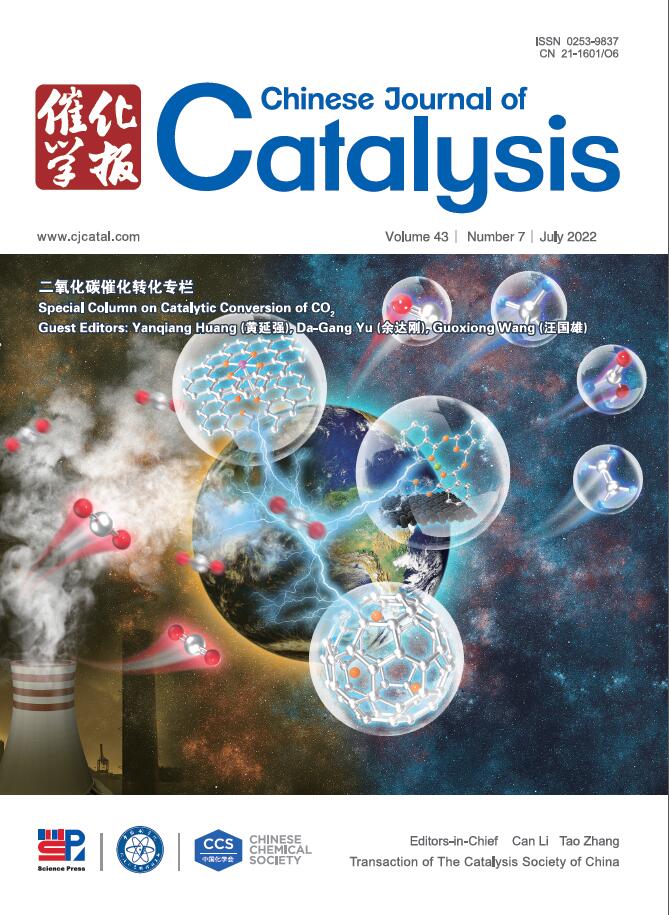Atomically dispersed Ba sites as electron promoters to enhance the performance for photoreduction of CO2
IF 15.7
1区 化学
Q1 CHEMISTRY, APPLIED
引用次数: 0
Abstract
The highly photocatalytic conversion of CO2 into valuable products is a promising method for mitigating the global greenhouse effect and increasing the energy supply. However, the utilization of electron-deficient active sites to activate CO2 leads to lower photocatalytic efficiency and selectivity. One effective strategy to improve CO2 photoreduction performance is making precise adjustments to the electronic structure of the photocatalyst. Herein, the defective TiO2 modified with Cu, Ba, and CuBa metal sites is synthesized via a simple photo-deposition method and applied for photoreduction of CO2. Among the prepared catalysts, Cu1Ba3/TiO2-SBO (TiO2-SBO: TiO2 with surface and bulk oxygen vacancies) has been demonstrated to possess excellent photocatalytic conversion of CO2, with the activity levels of the CO and CH4 that are 8 and 6 times higher than the bare TiO2-SBO, and the electron selectivity of CO is up to 53%. The results reveal that oxygen vacancies and CuBa bimetallic sites have a synergistic ability to facilitate the separation of photogenerated carriers. Furthermore, the electron-donor Ba metal enables modulation of the electronic structure of Cu co-catalysts, generating electron-rich Cu metal sites that accelerate the activation of CO2. Meanwhile, the theoretical calculations prove that the Cu1Ba3/TiO2-SBO has the stronger CO2 adsorption energy, and its strengthened binding of *COOH and the markedly reduced formation energy of CO and *CO intermediates boost the conversion of COOH to CO and enhance the selectivity of CO. Thereby, the defective TiO2 modified with CuBa bimetal represents a more effective measure for CO2 reduction into valuable products.
原子分散的Ba位作为电子促进剂提高CO2光还原性能
高度光催化将二氧化碳转化为有价值的产品是缓解全球温室效应和增加能源供应的一种有前途的方法。然而,利用缺乏电子的活性位点来激活CO2会导致光催化效率和选择性降低。提高CO2光还原性能的一个有效策略是对光催化剂的电子结构进行精确调整。本文通过简单的光沉积方法合成了Cu、Ba和CuBa金属位修饰的缺陷TiO2,并将其应用于光还原CO2。在所制备的催化剂中,Cu1Ba3/TiO2- sbo (TiO2- sbo: TiO2具有表面和大块氧空位)对CO2具有优异的光催化转化效果,CO和CH4的活性水平分别是裸TiO2- sbo的8倍和6倍,CO的电子选择性高达53%。结果表明,氧空位和CuBa双金属位具有协同作用,有利于光生载流子的分离。此外,电子供体Ba金属能够调制Cu共催化剂的电子结构,产生富电子的Cu金属位点,加速CO2的活化。同时,理论计算证明Cu1Ba3/TiO2- sbo具有更强的CO2吸附能,其对*COOH的结合增强,CO和*CO中间体的生成能明显降低,促进了COOH向CO的转化,提高了CO的选择性。因此,用CuBa双金属修饰缺陷TiO2是将CO2还原为有价值产物的更有效措施。
本文章由计算机程序翻译,如有差异,请以英文原文为准。
求助全文
约1分钟内获得全文
求助全文
来源期刊

Chinese Journal of Catalysis
工程技术-工程:化工
CiteScore
25.80
自引率
10.30%
发文量
235
审稿时长
1.2 months
期刊介绍:
The journal covers a broad scope, encompassing new trends in catalysis for applications in energy production, environmental protection, and the preparation of materials, petroleum chemicals, and fine chemicals. It explores the scientific foundation for preparing and activating catalysts of commercial interest, emphasizing representative models.The focus includes spectroscopic methods for structural characterization, especially in situ techniques, as well as new theoretical methods with practical impact in catalysis and catalytic reactions.The journal delves into the relationship between homogeneous and heterogeneous catalysis and includes theoretical studies on the structure and reactivity of catalysts.Additionally, contributions on photocatalysis, biocatalysis, surface science, and catalysis-related chemical kinetics are welcomed.
 求助内容:
求助内容: 应助结果提醒方式:
应助结果提醒方式:


